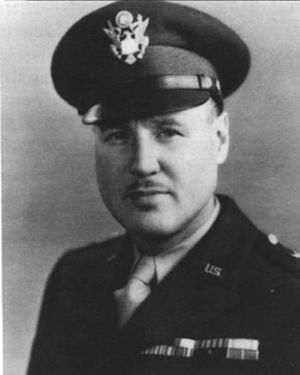Major General Kenneth Nichols (1907 – 2000) served as District Engineer of the Manhattan Engineer District.
As a lieutenant colonel, Nichols was selected as Deputy District Engineer by Colonel James Marshall. Responsible for selecting a construction site, the pair decided on Oak Ridge, Tennessee. Nichols was also in charge of ore procurement. He met with Edgar Sengier, who was expecting the visit and already had 1,200 tons of ore cached at a Staten Island warehouse. Arrangements were made to purchase the ore, which originated from the Belgian Congo.
One of General Leslie Groves‘ key lieutenants, Nichols was named District Engineer of the Manhattan Engineer District in 1943. He was consequently given responsibility for both the Clinton Engineer Works and the plutonium production facility at the Hanford site.
Nichols was awarded the Distinguished Service Medal for his work on the Manhattan Project. After the war, he was promoted to brigadier general and became General Groves’ deputy. Later promoted to major general, he served as deputy director of guided missiles for the Department of Defense before becoming general manager of the U.S. Atomic Energy Commission (AEC). In his role at the AEC, Nichols was a key figure in the revocation of J. Robert Oppenheimer’s security clearance.
He left government in 1955 to become a consulting engineer, and was retained by many prominent companies, including Alcoa and Westinghouse. Nichols died on February 21, 2000.
Articles from the Oak Ridger detailing more about Nichols and his family’s life, can be found here:
Meet Kenneth D. Nichols, the father of Oak Ridge, a leader in the making, Part 1 (1907-1929)
Kenneth D. Nichols, the father of Oak Ridge: Honing his engineer qualifications Part 2 (1932-1939)
How Nichols and Groves worked together on the Manhattan Project
The story of Col. Kenneth Nichols continues with Y-12, E.O. Lawrence, and the Calutron Girls
Kenneth D. Nichols the Father of Oak Ridge the Road to Trinity
Read about Nichols’ happiest ‘working day’ in Oak Ridge and some unsung heroes





